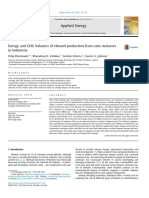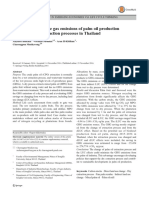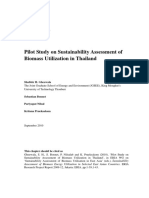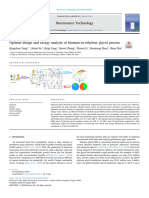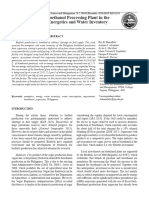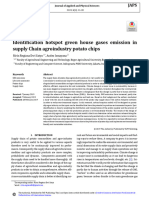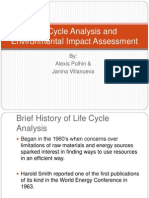Eco-Efficiency Assessment of Ethanol Production in Ethiopia: Product or Service Value Environmental Influence
Eco-Efficiency Assessment of Ethanol Production in Ethiopia: Product or Service Value Environmental Influence
Uploaded by
AshenafiCopyright:
Available Formats
Eco-Efficiency Assessment of Ethanol Production in Ethiopia: Product or Service Value Environmental Influence
Eco-Efficiency Assessment of Ethanol Production in Ethiopia: Product or Service Value Environmental Influence
Uploaded by
AshenafiOriginal Description:
Original Title
Copyright
Available Formats
Share this document
Did you find this document useful?
Is this content inappropriate?
Copyright:
Available Formats
Eco-Efficiency Assessment of Ethanol Production in Ethiopia: Product or Service Value Environmental Influence
Eco-Efficiency Assessment of Ethanol Production in Ethiopia: Product or Service Value Environmental Influence
Uploaded by
AshenafiCopyright:
Available Formats
International Journal of Engineering, Applied and Management Sciences Paradigms (IJEAM)
Eco-Efficiency Assessment of Ethanol
Production In Ethiopia
Elias W. Gabisa1, Shabbir H. Gheewala2
1
The Joint Graduate School of Energy and Environment,
King Mongkut’s University of Technology Thonburi, 126 Pracha uthit Road, Centre for Energy Technology and
Environment, PERDO, Bangkok, Thailand, Faculty of Chemicaland Food Engineering, Bahir Dar Institute of
Technology, Bahir Dar University, Bahir Dar,Ethiopia
2
The Joint Graduate School of Energy and Environment,
King Mongkut’s University of Technology Thonburi, 126 Pracha uthit Road,
Centre for Energy Technology and Environment, PERDO, Bangkok 10140, Thailand
Abstract- The sustainability of ethanol production in Ethiopia is assessed using ‘eco-efficiency’ indicator, which is a
combined economic and environmental sustainability indicator. The Gross value added (US$) and the life cycle
greenhouse gas (GHG) emissions (kgCO2eq) are selected as the indicators for characterizing economic and environmental
performance, respectively. The results revealed that the alternative of mechanized farming along with cane trash
utilization for power generation and bioslurry as a fertilizer had the highest eco-efficiency. This is because of using the
byproducts and avoiding cane trash burning which decreases the GHG emissions while increasing the value addition.
Shifting to mechanized harvesting and using cane trash as energy source has revealed an increase in eco-efficiency of
more than 40%. Improving sugarcane biomass utilization across the entire sugarcane system would enhance the
sustainability of the ethanol production system.
Key words: Ethanol; Eco-efficiency; Ethiopia; GHG emissions; GVA
I. INTRODUCTION
Biomass energy utilization is becoming a key energy strategy of many countries because of the issue of energy
security and climate change [1]. The case is beyond climate change and energy security for developing countries
like Ethiopia since more of the economy is dependent on agriculture, it promotes the agricultural sector
development. Having a potential of bioenergy, 750 PJ per annum from different biomass resources, the sector
contribution to the economy is still low [2]. Ethanol production from sugarcane molasses is getting high recognition
throughout the world as it is produced from the byproduct of sugar processing. When we look at the complete
picture of the ethanol sector, it comes with much diversified products like bagasse, cane trash, filter cake, and
molasses [3–6]. These have a variety of advantages if appropriately utilized for different purposes like energy
generation from cane trash and vinasse, and using vinasse as fertilizer in the cane field. Therefore, technologies are
being developed for effective and efficient utilization of the byproducts from the sugarcane sector. For example,
biogas production from wastewater vinasse is being used in city buses in Brazil [7]. The cane trash can also be used
for electricity generation in cogeneration power plant [8].
Sugar production started in Ethiopia around the 1950s by cultivating 35,000 ha and 12,500 tonne per day collective
crushing capacity of four factories. Nowadays the sugar production has been boosted to 400,000 tonnes and the
cultivation area is expanded to 65,000 ha. The ethanol production has also been increased from 7,000 m3 to 20,000
m3 per day [9]. Despite these improvements,the situation is still not satisfactory when compared with other
countries like India, Thailand, and Brazil. Even though the ethanol sector in Ethiopia has been gradually developing,
there are yet no studies conducted on environmental as well as socio-economic sustainability of the sector.
Therefore, this paper aims to assess the sustainability of ethanol production in Ethiopia considering of combined
environmental and economic sustainability indicator called ‘Eco-efficiency’.
II. METHODOLOGY
2.1 Eco-efficiency
The eco-efficiency concept was developed in 1992 by the World Bank. Since it brings together the very important
ingredients of environment and economy, it has been widely recognized by the business sector [10]. Eco-efficiency
has been recently used to evaluate the sustainability of different products such as: Molasses ethanol [11], farm scale
biogas [12] and biodiesel from Jatropha curcas fruit [13]. Eco-efficiency is generally represented as Equation 1
below:
Product or Service Value
(1)
Environmental Influence
Volume 54 Issue 1 April 2019 389 ISSN 2320-6608
International Journal of Engineering, Applied and Management Sciences Paradigms (IJEAM)
There are different indicators suggested by developers and used by the researchers, like gross value added
(economic) and, energy consumption and greenhouse gas (GHG) emission (environmental). In this particular paper,
gross value added is considered as an indicator of the product value and life cycle GHG emissions as an
environmental indicator.
So, the eco-efficiency is re-stated asin Equation 2 below:
Gross Value Added GVA
Eco − efficiency = (2)
GHG emissions
Gross Value added
Gross value added (GVA) is the difference between market price and production cost of the product as in Equation
3.
Gross Value addedproduct = Selling Priceproduct − Production Cost product (3)
The final products obtained along the life cycle of ethanol production in Ethiopia are sugar, hydrous and anhydrous
ethanol [Table 1]. For a fair comparison of the different alternative scenarios, the GVA and GHG emissions are
considered based on the same reference flow i.e. per tonne of sugarcane processed.
Table 1: Market prices of final products
Products Market Price Production cost
Sugar 16 5.75
Molasses Ethanol Hydrous 14.59 4.15
Anhydrous 9.37 5.29
a The unit for market and production cost of sugar is ETB/ kg and it is ETB/L for molasses (1 USD = 28.3 ETB)
Different alternative scenarios have been considered in this study [Table 2]. The alternatives are developed based on
the byproduct (cane trash and vinasse) utilization within or out of the production value chain and changing the
agricultural practice in the sugarcane farming i.e. from manual harvesting to mechanical harvesting.
Table 2: Definition of different alternative scenarios
Scenarios Description
Base case Conventional sugarcane farming + sugar processing + ethanol processing
Alternative 1 Base case + bioslurry utilization + biogas electricity
Alternative 2 Alternative 1 + mechanical harvesting + electricity from cane trash burning
2.2 Life cycle GHG emissions
Life cycle assessment (LCA) methodology was applied to calculate the GHG emissionsfrom ethanol production in
Ethiopia. This ISO-standardized methodology has become mainstream in environmental impact assessments of
supply chains [14,15]. It has already been applied by various researchers to assess the impacts of ethanol production
in several countries, e.g. in Nepal and Indonesia [16], in Thailand[17], in China [18] and in Brazil [19]. The LCA
software SimaProV8 was used to build up the process trees and compile the results based on the ReCiPe 2016
midpoint Hierarchist method for the impact characterization. The emission factors for this case study were taken
from scholarly published papers and a well-known database, GREET 1.7 [20]. The US Environmental Protection
Agency (EPA) emission factors were also used for emissions related to fertilizer application and production [21].
The applied fertilizer was N-fertilizer in a ratio of 46:0:0 (N: P: K) and NPS in the ratio of 6:20:10 (N: P: S).
The other source of emission is cane trash burning. Even though it is not recommended, the practice of cane trash
burning is being used as the only way of trash removal in sugarcane farming in Ethiopia. The method for
determination of non-CO2 emissions from sugarcane burning is adopted from Nguyen et al. 2007 [6]. Since cane
trash is biomass and hence considered carbon neutral, CO2 emission from burning of the cane trashis not accounted
for in the GHG emission calculations.
III. RESULT AND DISCUSSION
3.1 Life cycle GHG emissions of the different alternative scenarios
The GHG emissions obtained are 54.4, 55.67, and 35.27 kgCO2eq per GJ of ethanol produced for base case,
Alternative 1 and Alternative 2 respectively. In the case of the base case and Alternative 1, 75% of the GHG
emission is contributed from the sugarcane burning while it accounts for 58 % in the case of Alternative 2. The
results revealed that the improvement of sugarcane farming practice (changing from manual to mechanical) and
integrated utilization of cane trash and vinasse brings about a reduction in GHG emissions of the final products i.e.
molasses ethanol and the sugar. This implies that proper utilization of the different byproducts for different purposes
Volume 54 Issue 1 April 2019 390 ISSN 2320-6608
International Journal of Engineering, Applied and Management Sciences Paradigms (IJEAM)
can help improve the GHG emission performance of molasses ethanol production. Mechanized farming combined
with cane trash utilization for electricity generation shows the highest GHG emissions reduction, which is the case
of Alternative 2 [Figure 1]. Using bioslurry from the biogas plant from ethanol wastewater did not show much
improvement in GHG emission. However, the application of the bioslurry provided extra benefit of moisturizing the
soil so that the quality of the soil also improved. The other contributor to GHG emission is the consumption of lime
and phosphoric acid during molasses generation in base case and Alternative 1. In the case of Alternative 2, the
contribution from agriculturedecreases by50 %. The contribution from ethanol processing, estimated 9%, comes
from consumption of urea in the fermentation process.
10
GHG emission (kgCO2eq/t cane)
0
Agriculture
Agriculture
Agriculture
Ethanol processing
Ethanol processing
Ethanol processing
Molasses generation
Molasses generation
Molasses generation
Total GHG emissions
Total GHG emissions
Total GHG emissions
Base Alternative 1 Alternative 2
Figure 1: Life cycle GHG emission contribution of different life cycle stages of ethanol production in Ethiopia
60
50
GHG emission (kgCO2eq/GJ)
40
30
20
10
0
processing
processing
processing
generation
generation
generation
Agricultur
Total GHG
Agricultur
Total GHG
Agricultur
Total GHG
Molasses
Molasses
Molasses
emissions
emissions
emissions
Ethanol
Ethanol
Ethanol
e
Volume 54 Issue 1 April 2019 391 ISSN 2320-6608
International Journal of Engineering, Applied and Management Sciences Paradigms (IJEAM)
3.2 Gross value added
The gross value added of the products are calculated using Equation 3 and the data provided in Table 1. For the base
case scenario, the production cost of the products and selling prices along the value chain are applied. Alternative 1
assumes there is negligible additional value added from the fertilizer (bioslurry from biogas production) as there is
no market for that. For the Alternative 2, the cost of fuel consumed in mechanical harvester and cane trash
transportation to the factory is assumed more or less similar with the labor payment for manual harvesting per tonne
of cane. This is in line with studies from Sudan and India.For example, in the case of Sudan’s sugarcane farming
practice, the cost of manual harvesting is 0.19 US$ while for mechanical harvesting is 0.1US$ per tonne of cane
[22]. Similarly, in India the cost of manual harvesting is higher than mechanical harvesting by 44%, which shows a
similar implication with previous study in Sudan [23].Cane trash transportation fuel consumption cost (0.1US$ per
tonne of cane) is taken in to consideration to calculate the cost of cane trash transportation to the factory. Therefore,
the cost of mechanical harvesting (0.1 US$ per tonne of cane) plus the cost of cane trash transportation is summed
up to 0.2US$ per tonne of cane (~0.19US$ per tonne of cane), which is cost for manual harvesting. To determine the
value addition from cane trash recovery for electricity generation, the current selling price of electricity of 0.06
$USD is considered. The production cost of the electricity is collected from factory data for bagasse electricity,
which is 0.015US$. Considering the above assumptions the overall value addition from mechanical harvesting and
cane trash recovery is estimated to be 0.4US$ per tonne of cane [Table 3].
Eco-efficiency analysis
The eco-efficiency of the three products (Sugar, Hydrous Ethanol and Anhydrous Ethanol) is determined
considering the market values of the product in the current market per cubic metre of ethanol produced [Table 3].
Even though prices of products are generally highly volatile, in Ethiopia since all those products are produced from
the government company, their price were fixed for the last three years.
Table 3: Eco-efficiency of bio-refinery system in Ethiopia
Alternatives Total GHG emission Gross value Added Eco-Efficiency
(kgCO2eq/t cane) (US$/t cane) (US$/ kgCO2eq)
Base 8.90 44.6 5.01
Alternative 1 9.07 44.6 4.92
Alternative 2 5.7 45 7.9
Note: Conversion rate of 28.3 ETB = 1USD is considered
The eco-efficiency analysis shows that using vinasse as a fertilizer and cane trash for excess electricity, which will
contribute in a reduction of GHG emissions greatly is more favorable than that of the other systems [Figure 2].
5
Eco-efficiency of products
4.5
4
(US$/kgCO2eq
3.5
3
2.5
2
1.5
1
0.5
0
Base Alt1 Alt2 Base Alt 1 Alt 2 Base Alt 1 Alt 2
Sugar Hydrous Ethanol Anhydrous Ethanol
Figure 2: Eco-efficiency of different ethanol production alternatives
Volume 54 Issue 1 April 2019 392 ISSN 2320-6608
International Journal of Engineering, Applied and Management Sciences Paradigms (IJEAM)
3.5
2.5
1.5
0.5
0
Base Alt 1 Alt 2 Base Alt 1 Alt 2 Base Alt 1 Alt 2
Hydrous Ethanol Anhydrous Ethanol Sugar
Eco-efficiency Eco-efficiency
IV. CONCLUSION
From the study, it is concluded that utilizing the byproducts as much as possible with in the ethanol-processing
framework significantly increases the eco-efficiency of the products. Utilizing all the cane trash for energy
production and changing the harvesting mechanism from manual (which includes trash pre-harvest burning) to
mechanical shows above 40% more eco-efficiency than the other alternatives. The eco-efficiency indicator is more
sensible than other non-combined indicators to show the sustainability of the ethanol and other products. The gross
value addition from shifting to Alternative 2 to the base case scenario is not much significant. This is because the
cost incurred for fuel consumption in mechanical harvesting and sugarcane trash transportation is almost equal with
the cost of manual harvesting (only 5% difference). The advantage of electricity from the cane trash has some value
addition to the ethanol production; still the estimated production cost in the factory is not established. Therefore, the
production cost of bagasse electricity is assumed in this calculation. The increased value of eco-efficiency indicator
of Alternative 2 relative to the base case can imply a better sustainability because the net value added was increased
as well as the net GHG emissions were decreased
V. REFERENCES
[1] L.T. Yan J, Biofuels in Asia, 86 (2009) 1–10.
[2] E.W. Gabisa, S.H. Gheewala, Potential of bio-energy production in Ethiopia based on available biomass residues, Biomass and Bioenergy.
111 (2018) 77–87.
[3] I. De Carvalho, M. Núcleo, I. De Planejamento, C.C.T.C. Copersucar, Assessment of greenhouse gas emissions in the production and use of
fuel ethanol in Brazil, 2004.
[4] T. Silalertruksa, S.H. Gheewala, The environmental and socio-economic impacts of bio-ethanol production in Thailand, Energy Procedia. 9
(2011) 35–43.
[5] D. Khatiwada, B.K. Venkata, S. Silveira, F.X. Johnson, Energy and GHG balances of ethanol production from cane molasses in Indonesia,
Appl. Energy. 164 (2016) 756–768.
[6] T.L.T. Nguyen, S.H. Gheewala, Life cycle assessment of fuel ethanol from cane molasses in Thailand, Int. J. Life Cycle Assess. 13 (2008)
301–311.
[7] A.P. Bernal, I.F.S. dos Santos, A.P. Moni Silva, R.M. Barros, E.M. Ribeiro, Vinasse biogas for energy generation in BrazilAn assessment
of economic feasibility, energy potential and avoided CO2emissions, J. Clean. Prod. 151 (2017) 260–271.
[8] J. Smithers, J. Smithers, Review of sugarcane trash recovery systems for energy cogeneration in South Africa Review of sugarcane trash
recovery systems for energy cogeneration in South Africa, Renew. Sustain. Energy Rev. (2019) 1–11.
[9] G. Wondimu, Ethiopian sugar corporation’s profile, (2010) 1–22.
[10] H. Verfaillie, R. Bidwell, A Guide to reporting company performance, (2000) 39.
[11] T. Silalertruksa, S.H. Gheewala, P. Pongpat, Sustainability assessment of sugarcane biorefinery and molasses ethanol production in
Thailand using eco-efficiency indicator, Appl. Energy. 160 (2015) 603–609.
[12] M.T.M. Lijó, Y. L.Toja, S. G.García, J. Bacenetti , M. Negri, Eco-efficiency assessment of farm-scaled biogas plants, Bioresour. Technol.
237 (2017) 146–155.
[13] I. Castañeda, V. Bojacá, G. Ramos, A. Santis, P. Acevedo, Study of the eco-efficiency of biodiesel production from the fruit of the jatropha
curcas plant, Chem. Eng. Trans. 58 (2017) 493–498.
Volume 54 Issue 1 April 2019 393 ISSN 2320-6608
International Journal of Engineering, Applied and Management Sciences Paradigms (IJEAM)
[14] ISO 2006, EN 14040: Environmental management-Life cycle assessment-Requirements and guidelines.
[15] ISO 2006, EN 14044:Environmental management-Life cycle assessment-Principles and framework.
[16] D. Khatiwada, B.K. Venkata, S. Silveira, F.X. Johnson, Energy and GHG balances of ethanol production from cane molasses in Indonesia,
Appl. Energy. 164 (2016) 756–768.
[17] T.L.T. Nguyen, S.H. Gheewala, S. Garivait, Full chain energy analysis of fuel ethanol from cassava in Thailand, Environ. Sci. Technol. 41
(2007) 4135–4142.
[18] M. Wang, Y. Shi, X. Xia, D. Li, Q. Chen, Life-cycle energy efficiency and environmental impacts of bioethanol production from sweet
potato, Bioresour. Technol. 133 (2013) 285–292.
[19] I.C. Macedo, J.E.A. Seabra, J.E.A.R. Silva, Green house gases emissions in the production and use of ethanol from sugarcane in Brazil: The
2005/2006 averages and a prediction for 2020, Biomass and Bioenergy. 32 (2008) 582–595.
[20] M. Wang, Life cycle analysis approach and key issues, GREET Train. Work. (2012).
[21] USEPA, Application Draft Report Emission Factor Documentation for AP-42 Fertilizer Application Draft Report, Reports Environ. Prot.
Agency. (1998).
[22] A.E. Ahmed, A.O.M. Alam-Eldin, An assessment of mechanical vs manual harvesting of the sugarcane in Sudan – The case of Sennar
Sugar Factory, J. Saudi Soc. Agric. Sci. 14 (2015) 160–166.
[23] B. Anjaneyulu, D. Maheshwar, K. Gopi, J. Srinivas, C.S. kumar, N. Manikyam, R. Harsha Nag, Performance Evaluation of Mechanical and
Manual Harvesting of Sugarcane, Int. J. Curr. Microbiol. Appl. Sci. 7 (2018) 3779–3788.
Volume 54 Issue 1 April 2019 394 ISSN 2320-6608
You might also like
- The Ford Motors StrategiesDocument25 pagesThe Ford Motors StrategiessabaNo ratings yet
- Corn to Ethanol - Design, simulate and statistical optimization for sustainable biofuel productionDocument22 pagesCorn to Ethanol - Design, simulate and statistical optimization for sustainable biofuel productionSRINIVASAN TNo ratings yet
- Sistemasdereactores 9349Document8 pagesSistemasdereactores 9349IlireaNo ratings yet
- 10 1016@j Biortech 2016 02 049Document10 pages10 1016@j Biortech 2016 02 049DiLa CuteNo ratings yet
- Economics of Bioethanol From Rice StrawDocument8 pagesEconomics of Bioethanol From Rice StrawJosé Alberto CastilloNo ratings yet
- Summary of Bio-MEG ReportDocument6 pagesSummary of Bio-MEG ReportsimaproindiaNo ratings yet
- Applied Energy: Dilip Khatiwada, Bharadwaj K. Venkata, Semida Silveira, Francis X. JohnsonDocument13 pagesApplied Energy: Dilip Khatiwada, Bharadwaj K. Venkata, Semida Silveira, Francis X. JohnsonAdemar EstradaNo ratings yet
- Journal of Cleaner Production: Elias W. Gabisa, C Ecile Bessou, Shabbir H. GheewalaDocument11 pagesJournal of Cleaner Production: Elias W. Gabisa, C Ecile Bessou, Shabbir H. GheewalaAshenafiNo ratings yet
- Carbon Balance of Sugarcane Bioenergy SystemsDocument10 pagesCarbon Balance of Sugarcane Bioenergy SystemsYusron MustainNo ratings yet
- Paper BioDocument17 pagesPaper BioI-hana D'yanaNo ratings yet
- Eco-Efficiency Assessment of Bioplastics Production Systems and End-of-Life OptionsDocument15 pagesEco-Efficiency Assessment of Bioplastics Production Systems and End-of-Life Optionskemche610No ratings yet
- 1 s2.0 S1876610215000648 MainDocument8 pages1 s2.0 S1876610215000648 MainRobert GilmoreNo ratings yet
- Life Cycle Assessment of Bio-Based Ethanol Produced From Different Agricultural FeedstocksDocument11 pagesLife Cycle Assessment of Bio-Based Ethanol Produced From Different Agricultural FeedstocksGraciaVelitarioNo ratings yet
- Life Cycle Impact Assessment On ElectricDocument11 pagesLife Cycle Impact Assessment On Electricarie2000No ratings yet
- The Feasibility Study of Producing BioethanolDocument23 pagesThe Feasibility Study of Producing BioethanolGorbyNo ratings yet
- Sustainability 12 03793Document17 pagesSustainability 12 03793julianNo ratings yet
- Comparism of The Properties and Yield of Bioethanol From Mango and Orange WasteDocument11 pagesComparism of The Properties and Yield of Bioethanol From Mango and Orange WasteAZOJETENo ratings yet
- Techno-Economic Study of Bioethanol Production FroDocument13 pagesTechno-Economic Study of Bioethanol Production FroAlothman ONo ratings yet
- processes-07-00670-v2Document31 pagesprocesses-07-00670-v2ANIS ATIKAH AHMADNo ratings yet
- Economic feasibility of a pilot-scaleDocument9 pagesEconomic feasibility of a pilot-scaleHelia ZakerhosseiniNo ratings yet
- Recycling Agricultural Wastes and By-Products in Organic Farming: Biofertilizer Production, Yield Performance and Carbon Footprint AnalysisDocument17 pagesRecycling Agricultural Wastes and By-Products in Organic Farming: Biofertilizer Production, Yield Performance and Carbon Footprint Analysisdanutu fanelNo ratings yet
- Bioconversion of Food Waste To EnergyDocument22 pagesBioconversion of Food Waste To EnergykhawarkhubaibNo ratings yet
- Life Cycle Greenhouse Gas Emissions of Palm Oil Production by Wet and Dry Extraction Processes in ThailandDocument13 pagesLife Cycle Greenhouse Gas Emissions of Palm Oil Production by Wet and Dry Extraction Processes in ThailandMangasa SiregarNo ratings yet
- Processes 07 00458 PDFDocument16 pagesProcesses 07 00458 PDFhmossNo ratings yet
- Watanabe Et Al WorkDocument11 pagesWatanabe Et Al WorkSuraj Kumar SamalNo ratings yet
- Rajabihamedani 2019Document11 pagesRajabihamedani 2019M Yousaf YaqoobNo ratings yet
- Anuj Kumar ChandelDocument29 pagesAnuj Kumar ChandelManassés Pinto Silva JuniorNo ratings yet
- COZMA AdrianaDocument7 pagesCOZMA Adrianakeepemdown17No ratings yet
- Journal Pre-Proofs: EngineeringDocument14 pagesJournal Pre-Proofs: EngineeringMuhammad BilalNo ratings yet
- RPR FY2009 12 Country ReportsDocument312 pagesRPR FY2009 12 Country ReportsSuraj Kumar SamalNo ratings yet
- Wood PelletDocument9 pagesWood Pellettopollillo24No ratings yet
- Energy Analysis For Biodiesel Production From Rapeseed Oil: H. Huseyin OzturkDocument27 pagesEnergy Analysis For Biodiesel Production From Rapeseed Oil: H. Huseyin OzturkLaukik PawarNo ratings yet
- Design, Sustainability Analysis and Multiobjective Optimisation of Ethanol Production Via Syngas FermentationDocument30 pagesDesign, Sustainability Analysis and Multiobjective Optimisation of Ethanol Production Via Syngas FermentationGraciaVelitarioNo ratings yet
- 1Document9 pages1kingtrosqui1No ratings yet
- Guerrero Munoz 2018 PDFDocument8 pagesGuerrero Munoz 2018 PDFIzzat ZakwanNo ratings yet
- Process Design and Comprehensive 3E Analysis of Low Carbon Diol Production With and Without Heat IntegrationDocument11 pagesProcess Design and Comprehensive 3E Analysis of Low Carbon Diol Production With and Without Heat IntegrationIntan SyahirahNo ratings yet
- 1 s2.0 S2589014X21003133 MainDocument13 pages1 s2.0 S2589014X21003133 MainFelipe RojasNo ratings yet
- Soy Vs Petro PolyolsDocument5 pagesSoy Vs Petro PolyolsA MahmoodNo ratings yet
- Life Cycle Assessment of Bio-Ethanol Derived From CelluloseDocument5 pagesLife Cycle Assessment of Bio-Ethanol Derived From CelluloseVictoria SantosNo ratings yet
- 1 s2.0 S0959652615002140 Main PDFDocument10 pages1 s2.0 S0959652615002140 Main PDFMaliha CheemaNo ratings yet
- (Done) Energy BalanceDocument10 pages(Done) Energy BalanceMohd Syazwan Mohd PataniNo ratings yet
- Energy and Water Optimization in BiofuelDocument17 pagesEnergy and Water Optimization in Biofuelfathi kyutiNo ratings yet
- Battista 2020Document18 pagesBattista 2020Ingryd Mayer KrinskiNo ratings yet
- Assignment 1 Che 544 - Group 6Document29 pagesAssignment 1 Che 544 - Group 6atikah hasnor100% (1)
- GJESM - Volume 10 - Issue 2 - Pages 837-856Document20 pagesGJESM - Volume 10 - Issue 2 - Pages 837-856Ad NaturecertNo ratings yet
- Bioethanol Production From Pistachio Pistacia Vera L Shells Applying Ozone Pretreatment and Subsequent Enzymatic HydrolysisDocument10 pagesBioethanol Production From Pistachio Pistacia Vera L Shells Applying Ozone Pretreatment and Subsequent Enzymatic HydrolysisBetül GöncüNo ratings yet
- 454-Article Text-1378-1-10-20210106Document9 pages454-Article Text-1378-1-10-20210106kdm895101No ratings yet
- Renewable Energy: Nur Izzah Hamna A. Aziz, Marlia M. Hana FiahDocument11 pagesRenewable Energy: Nur Izzah Hamna A. Aziz, Marlia M. Hana Fiahagungtiyo21No ratings yet
- Enhancing The Heating Properties of AgriDocument16 pagesEnhancing The Heating Properties of AgriBALOGUNNo ratings yet
- RERA Volume2 Issue1 Pages51-69Document20 pagesRERA Volume2 Issue1 Pages51-69Chinwuba Samuel EbukaNo ratings yet
- How Does Technology Pathway Choice Influence Economic Viability and Environmental Impacts of Lignocellulosic Biorefineries?Document19 pagesHow Does Technology Pathway Choice Influence Economic Viability and Environmental Impacts of Lignocellulosic Biorefineries?Karthik RajendranNo ratings yet
- Identification Hotspot Green House Gases EmissionDocument8 pagesIdentification Hotspot Green House Gases EmissionProsie VNo ratings yet
- Biogas MethanolDocument8 pagesBiogas MethanolYimet YQNo ratings yet
- Sustainable Energy Technologies and Assessments: Hasan Yildizhan, Morteza Taki, Mustafa Ozilgen, Shiva GorjianDocument10 pagesSustainable Energy Technologies and Assessments: Hasan Yildizhan, Morteza Taki, Mustafa Ozilgen, Shiva GorjianAlso FísicaNo ratings yet
- Biogas From Cow ManureDocument9 pagesBiogas From Cow ManureVenu VasudevNo ratings yet
- Life Cycle Assessment (LCA) in Pulp & Paper Mills: Comparison Between MFO With Biomass in Lime KilnDocument5 pagesLife Cycle Assessment (LCA) in Pulp & Paper Mills: Comparison Between MFO With Biomass in Lime KilnRafael FerolaNo ratings yet
- Life Cycle Analysis and Environmental Impact Assessment97Document63 pagesLife Cycle Analysis and Environmental Impact Assessment97Alexis PulhinNo ratings yet
- Biomass and Bioenergy 2012 - Emergy Analysis of Oil Production From MicroalgaeDocument8 pagesBiomass and Bioenergy 2012 - Emergy Analysis of Oil Production From MicroalgaeNojus DekerisNo ratings yet
- Economicsof Organic Rice ProductionDocument8 pagesEconomicsof Organic Rice ProductionKezia AvilaNo ratings yet
- Innovation Outlook: Renewable MethanolFrom EverandInnovation Outlook: Renewable MethanolNo ratings yet
- Ex-Ante Carbon-Balance Tool for Value Chains: EX-ACT VC – GuidelinesFrom EverandEx-Ante Carbon-Balance Tool for Value Chains: EX-ACT VC – GuidelinesNo ratings yet
- Malaysian-Danish Country Programme For Cooperation in Environment and Sustainable Development (2002-2006)Document63 pagesMalaysian-Danish Country Programme For Cooperation in Environment and Sustainable Development (2002-2006)AshenafiNo ratings yet
- Biomass and Bioenergy: H. Mandova, S. Leduc, C. Wang, E. Wetterlund, P. Patrizio, W. Gale, F. KraxnerDocument13 pagesBiomass and Bioenergy: H. Mandova, S. Leduc, C. Wang, E. Wetterlund, P. Patrizio, W. Gale, F. KraxnerAshenafiNo ratings yet
- The Impacts of The Domestic Fuel Increases On Prices of The Indonesian Economic SectorsDocument9 pagesThe Impacts of The Domestic Fuel Increases On Prices of The Indonesian Economic SectorsAshenafiNo ratings yet
- Energy Policy: ViewpointDocument6 pagesEnergy Policy: ViewpointAshenafiNo ratings yet
- Biomass and Bioenergy: Elias W. Gabisa, Shabbir H. GheewalaDocument11 pagesBiomass and Bioenergy: Elias W. Gabisa, Shabbir H. GheewalaAshenafiNo ratings yet
- Journal of Cleaner Production: Elias W. Gabisa, C Ecile Bessou, Shabbir H. GheewalaDocument11 pagesJournal of Cleaner Production: Elias W. Gabisa, C Ecile Bessou, Shabbir H. GheewalaAshenafiNo ratings yet
- GabissaDocument19 pagesGabissaAshenafiNo ratings yet
- Thermal Physics: Too Many Particles Mentioned Above)Document20 pagesThermal Physics: Too Many Particles Mentioned Above)AshenafiNo ratings yet
- The Story of Ireland: A Bridge Between Celtic and Modern, America and EuropeDocument34 pagesThe Story of Ireland: A Bridge Between Celtic and Modern, America and EuropePriscila PimentelNo ratings yet
- Realidad Virtual y Tratamientos Psicológicos.: Análisis y Modificación de Conducta February 1998Document28 pagesRealidad Virtual y Tratamientos Psicológicos.: Análisis y Modificación de Conducta February 1998TATIANA VILLANo ratings yet
- Market Segmentation 1 Market SegmentationDocument3 pagesMarket Segmentation 1 Market Segmentationruchibagal1993No ratings yet
- Graduation Script 2023Document4 pagesGraduation Script 2023jessa opiana100% (1)
- Azure PaaSDocument3 pagesAzure PaaSNew sonNo ratings yet
- Six Week Training Presentation On C++ Programming FromDocument64 pagesSix Week Training Presentation On C++ Programming FromloveleencheemaNo ratings yet
- Industrial Boiler PlantsDocument12 pagesIndustrial Boiler Plantsanon_411130333No ratings yet
- Case Study Analysis Using MS Word and MS Excel: Laboratory ExerciseDocument3 pagesCase Study Analysis Using MS Word and MS Excel: Laboratory ExerciseAbbegail CalinaoNo ratings yet
- Track & Trace Module: Mes Built On IgnitionDocument2 pagesTrack & Trace Module: Mes Built On IgnitionHéctor TostadoNo ratings yet
- IRFC ListofDesignatedBranches 03042023Document9 pagesIRFC ListofDesignatedBranches 03042023Saikat RoyNo ratings yet
- Establishing The Importance of The TopicDocument2 pagesEstablishing The Importance of The Topicfauno_ScribdNo ratings yet
- Evinrude Diagnostics Version 5 A Guide To Getting StartedDocument27 pagesEvinrude Diagnostics Version 5 A Guide To Getting StartedHidalgo FrancoNo ratings yet
- The 7 Main Story Elements and Why They MatterDocument11 pagesThe 7 Main Story Elements and Why They MatterΠΡΟΔΡΟΜΟΣ100% (3)
- Star Trek Picard - Opening Credits (Public Ver)Document2 pagesStar Trek Picard - Opening Credits (Public Ver)Georg ElserNo ratings yet
- Teachers Application FormDocument6 pagesTeachers Application FormVivekananda Kendra Shiksha Prasar Vibhag100% (1)
- What Is The Importance of Word Processing Applications in BusinessDocument2 pagesWhat Is The Importance of Word Processing Applications in Businessromskie galbanNo ratings yet
- Tapasya Academy Prospectus - 2017-18Document12 pagesTapasya Academy Prospectus - 2017-18Sunny SrivastavaNo ratings yet
- Wa0000Document90 pagesWa0000Mimi juwonNo ratings yet
- Stiffness Matrix Method For Nonlinear Analysis ofDocument9 pagesStiffness Matrix Method For Nonlinear Analysis ofjinshuaixuNo ratings yet
- Presentasi Coal MILL Pulverizer Modeling AwalDocument26 pagesPresentasi Coal MILL Pulverizer Modeling Awalbhisma aktaNo ratings yet
- Transcript of Applied Social SciencesDocument14 pagesTranscript of Applied Social SciencesIssaVillanuevaNo ratings yet
- ERC Grant Schemes Guide For Applicants: European Research CouncilDocument84 pagesERC Grant Schemes Guide For Applicants: European Research CouncilMagdalena NowaczykNo ratings yet
- Historical MethodologyDocument46 pagesHistorical Methodologyİrem GünayNo ratings yet
- Medicina Chinesa JeremyDocument2 pagesMedicina Chinesa JeremyJuan Gabriel CunhaNo ratings yet
- Principles and Practices of Transportation Planning and Engineering 1st Edition Tang Connie download pdfDocument40 pagesPrinciples and Practices of Transportation Planning and Engineering 1st Edition Tang Connie download pdfygorniaone100% (5)
- Green AccountingDocument4 pagesGreen AccountingUman Miftah SajidinNo ratings yet
- Sahyadri School & Aman SetuDocument28 pagesSahyadri School & Aman SetuMokshesh Jain100% (2)
- Paruelo. 1998. The Climate of Patagonia General Patterns and Controls On Biotic ProcessesDocument18 pagesParuelo. 1998. The Climate of Patagonia General Patterns and Controls On Biotic ProcessesMagdalena QuirogaNo ratings yet
- English 9 PDFDocument18 pagesEnglish 9 PDFDiane Jasmine JamandronNo ratings yet






